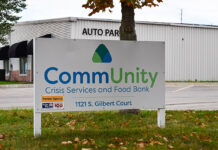by Bekah Porter
CORRIDOR – Time and again they came, asking for a place to spend the night.
“But we haven’t had the room,” said Sue Engle, an AmeriCorps Vista worker at the Catholic Work House in Cedar Rapids. “We’ve been that busy.”
By July 21, the 17-bed emergency homeless shelter had turned away 65 local people seeking room that month. A dozen more had been denied when they called from out-of-town.
For this reason, Ms. Engle expressed little surprise when a recent study by the Iowa Institute said that homelessness in Cedar Rapids increased 37.6 percent from 2009 to 2008.
“And that’s only taking into consideration the people they can count,” she said. “That doesn’t include the people who haven’t sought shelter or who sleep under the proverbial bridge. I’m not sure how accurate those numbers can ever really be.”
This sober news coincided with a positive announcement for the community.
CNN and Money Magazine selected Cedar Rapids as one of the “Best Places for Affordable Homes,” ranking the community 11th behind such other cities as San Antonio, Texas; Glendale, Ariz.; and Deerfield Beach, Fla. The publication listed Cedar Rapids’ median home price as $120,500, while Des Moines scored the number 10 slot with a median home price of $100,000.
“I can tell you that our people staying here would just have a staggering response if we told them that was affordable,” Ms. Engle said. “People don’t leave here and buy a house. They do leave here and find an apartment and get into transitional housing. But buying a house is not an option, really.”
And it will be an unlikely option for more and more people in the Cedar Rapids area, according to the Iowa Institute, who says that the average area resident pays an average of $14,436 to a mortgage each year.
The study found that some 2,651 people in Cedar Rapids have no homes, and of those, 1,782 were part of a family. More than 60 percent of those without homes were children.
That translated into about 5.3 percent of the town’s population being homeless or being at risk of losing regular shelter. Of those, 56.3 percent said they were in the situation for the first time.
“It’s easy to see, what with the unemployment rate being worse than usual,” Ms. Engle said. “And then you have the people who are stuck in a cycle of addiction or alcoholism.”
One major event not contributing to the homeless rate in the city was the 2008 floods. It played a minimum role, according to the institute, as 42 percent cited economics as the primary cause of homelessness.
Economics likely contributed to the increased foreclosure rate, as well.
According to real estate data and analysis company CoreLogic, foreclosure rates in Cedar Rapids rose to 1.75 percent for the month of May, which was a 0.28 percent from the same time period the year before. Additionally, 3.7 percent of mortgage loans were delinquent by 90 days or more, an increase of 0.58 percent.
Ms. Engle said she thinks the city should celebrate the recent honor for affordable housing, but they should do so with one thing in mind.
“Affordable doesn’t mean affordable for all,” she said. CBJ




